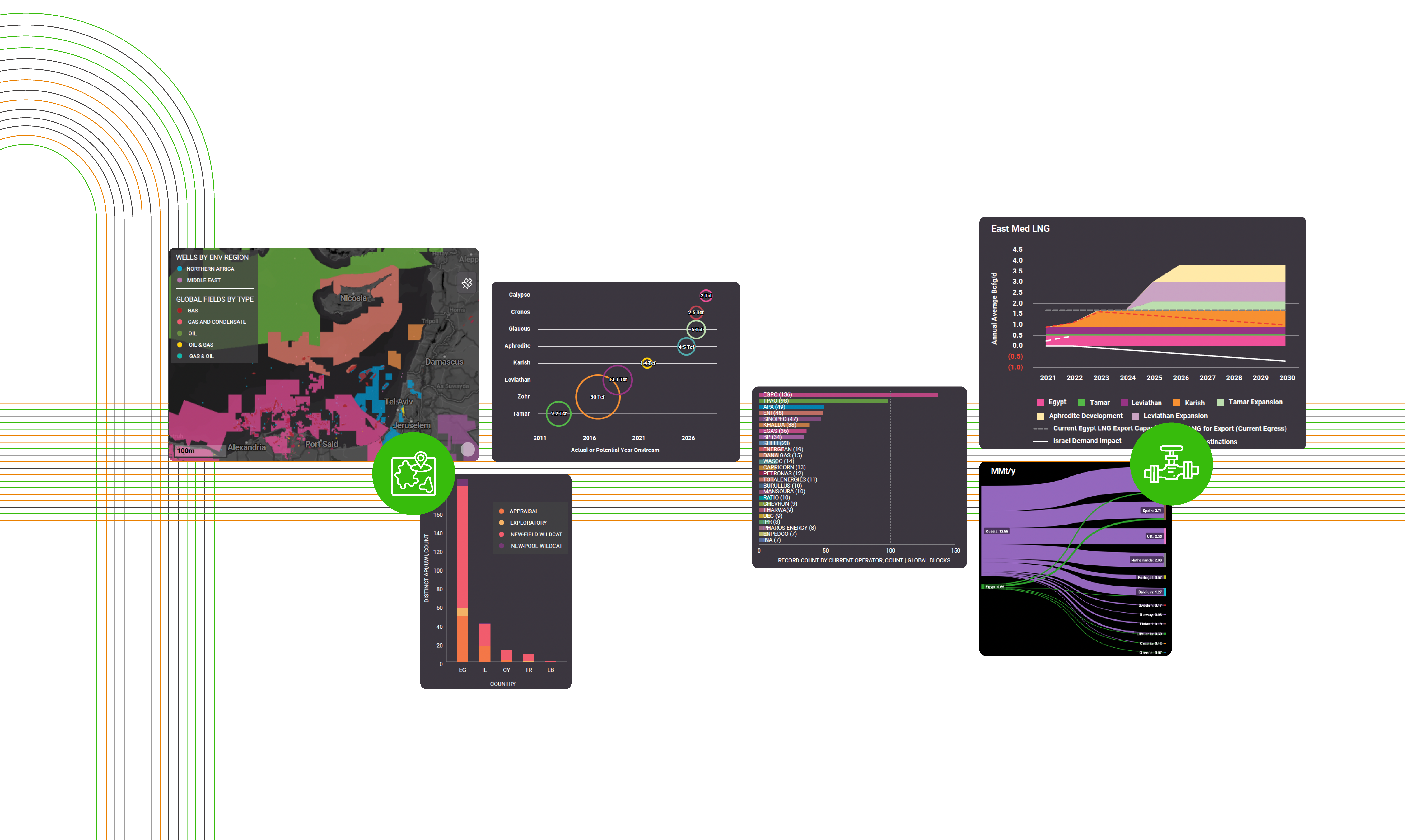Despite the Eastern Mediterranean (East Med) boasting significant offshore gas resources – producing assets in Egypt and Israel, as well as discovered but not yet developed fields in Cyprus – the region offers no near-term solution to European gas shortages driven by Russia’s progressive shutoffs.

Israel’s two producing fields, Tamar and Leviathan, produced a combined 1.9 Bctg/d in 2021. Both are exporting gas to Jordan (0.3 Bcfg/d) and Egypt (0.4 Bcfg/d). Egyptian gas production slipped this year to 6.7 Bcfqd from the average of ~7 Bcfg/d in 2021 due to natural decline at mature fields. Egypt exports its own gas and re-exports Israeli gas via its Damietta and dku LNG terminals, shipping 0.9 Bcfg/d in 2021 (53% of design capacity resulting from seasonal fluctuations caused by high domestic gas demand in summer).
The EU received just 0.1 Bcfa/d from Egypt in 2021. compared to the 1.7 Bcfq/d of Russian LNG it imported that year. Even if the East Med could fully displace Russian LNG, it would amount to just 11% of Russia’s total gas exports to the continent, most of which arrive via pipeline.
Other than Israel’s Karish field, which Energean will bring online in 3Q22 at an expected rate of 0.8 Bcfg/d, all other potential developments are still pre-FID and thus years from production. Chevron is actively considering expanding capacity from 1.1 Bcfg/d to 1.5 Bcfg/d at Tamar and from 1.2 Bcfg/d to 2.1 Bcfg/d at Leviathan. In Cyprus, Chevron is mulling the development of the Aphrodite Field (likely capacity 0.8 Bcfg/d), possibly undertaken in combination with the Leviathan expansion.
Further west, ExxonMobil’s Glaucus and Eni’s Calypso and Cronos discoveries hold potential. Resource volumes to date here have not proven sufficient to warrant greenfield developments, but success at Eni’s nearby Zeus 1 exploration well could bring forward field developments. Egypt offers limited potential for increasing gas production, with no big discoveries awaiting development.
The focus instead is on minimizing the decline of producing assets. The only way for the EU to source more East Med gas in the short term is for it to contract extra LNG cargoes from Egypt, which is exactly what it has been doing – albeit at a high cost – by outbidding Asian buyers.
Assuming Egypt’s LNG terminals were operating at their full capacity of 1.7 Bcfg/d, new LNG trains, floating LNG terminals, or the much-ballyhooed (and EU-backed) East Med pipeline (1.1-1.9 Bcfg/d capacity) would be necessary for the region’s gas to reach the EU market.
An additional consideration is regional gas demand. In Israel, domestic consumption is expected to grow from 1.2 Bcfg/d to 1.9 Bcfg/d by 2030, most of which will replace coal-fired power generation. Despite the Egyptian government’s stated intent and recent steps to reduce demand, 2021 consumption of 5.8 Bcfg/d is likely to grow unless there is (EU-funded?) heavy investment in renewables or other alternatives for power generation. Additionally, Egypt has resumed gas exports to Jordan via the Arab Gas Pipeline (up to 0.1 Bcfg/d) and in 2022 signed an agreement to export 0.06 Bcfg/d to Lebanon.
Given all the moving pieces, can the East Med provide the extra 1.6 Bcfg/d required by the EU to displace Russian LNG? The bloc already nearly tripled its share of Egypt LNG exports to 0.4 Bcfg/d in 1H22. If the EU also snapped up the Karish gas in 4Q22, this could result in an annual average increase of 0.5 Bcfg/d.
A full year of Karish gas volumes and higher LNG facility utilization rates should keep the impact of increased Israeli demand at bay in 2023, yielding an average additional 0.5 Bcfg/d – two-thirds of the way to fully replacing Russian LNG.
After these early wins, unless and until new gas developments come online, those EU-bound incremental volumes would gradually be taken up by Israel. Our high case regional development scenario has a total of 3.5 Bcfg/d available from the East Med by 2025, or 2.6 Bcfg/d more than in 2021.
In a best-case scenario, additional East Med gas volumes will ease tight EU gas balances but there will be very little reserves in the near term
Scout Signal derives insight from Enverus PRISM and the Enverus Global Scout Network. Find out more about Enverus Global Scout.

Discover
About Enverus
Resources
Follow Us
© Copyright 2024 All data and information are provided “as is”.